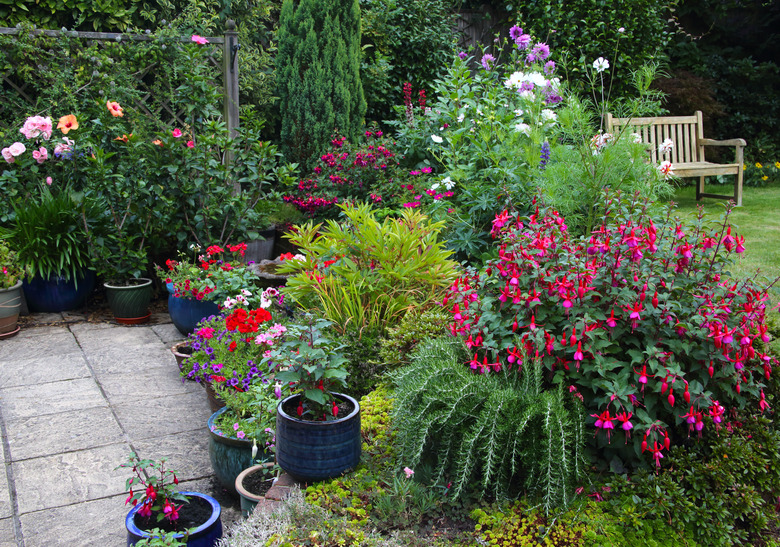How To Landscape A Flower Bed
We may receive a commission on purchases made from links.
There's no right or wrong way to design and landscape a flower bed. Formal gardens often follow a classic design of angular shapes and uniform colors while the cottage garden is an eclectic grouping of plants with soft edges and curving borders. No matter which type of flower bed you choose, there are some factors that are a constant. If you follow the key elements of gardening when you landscape a flower bed, your plants will be happy, healthy and pleasing to the eye.
Style Is Everything
Style Is Everything
The style of the flower bed could be formal, cottage, naturalized or a combination of these. American boxwood hedges (Buxus sempervirens) that grow as perennials in U.S. Department of Agriculture plant hardiness zones 5 through 8 can add an evergreen border in the formal garden, but creeping phlox (Phlox subulata, zones 3-9) may be better suited to a cottage-style flower bed. Local sandstone works well as a border for a naturalized garden.
Stately delphinium (Delphinium spp., zones 5-9) adds color and linear texture to a formal garden, while artemisia (Artemisia schmidtiana, zones 3-7) provides a soft flowing hint of velvety texture to a cottage garden. Trillium (Trillium grandiflorum, zones 4-8), garden phlox (Phlox paniculata, zones 4-8) and other native flowers provide color and texture to the naturalized garden, whereas black-eyed Susan (Rudbeckia fulgida, zones 3-9) and purple coneflower (Echinacea purpurea, zones 3-8) spray color out and upward throughout the season.
Landscape a Flower Bed: Location
Landscape a Flower Bed: Location
Location is important when you landscape a flower bed. Your site should showcase the grouping of plants from the angle you want it viewed.
The location also affects the growing conditions for your flowers. Your plants should match up with the amount of sunlight the site receives with shade plants for filtered sunlight and sun-loving plants for locations that receive six or more hours of sunlight each day. The soil should be a rich loamy mix that drains well. If you have problem soil, incorporating organic matter such as compost and leaf mold will help with drainage, and peat moss will aid in water retention.
A Practice Run
A Practice Run
When you landscape a flower bed, do a practice run by setting the plants in their pots in groupings around the garden site. The plants should complement each other and not compete. Tall plants, such as giant phlox, should go toward the back of a flower bed adjacent to the house or other structure. Circular or island gardens look best with the taller plants in the middle and the plants' height descending toward the outer edges.
Groupings of three shrubs are aesthetically more pleasing than a single specimen. Single blooming flowers, such as the black-eyed Susan or purple coneflower, are visually stunning when planted en masse. Empty spaces can be filled with annuals to add color when perennials aren't in bloom. View the flower bed from every angle to solidify the planting scheme.
Handling the Final Planting
Handling the Final Planting
String, landscape spray paint or a garden hose work well to mark the outer border of the flower bed. Mark a straight border for a formal garden or add curves for informal, cottage or naturalized gardens.
Once the border is marked, lift the sod from the area and add soil amendments. The soil should be tilled to a depth of about 8 to 12 inches. Transplant new plants into the flower bed in the early morning to reduce transpiration in the plants. Water the plants until the moisture reaches the roots. Keep the soil slightly moist until the plants acclimate to the new garden.
Sketching Garden Layouts
Sketching Garden Layouts
Landscape artists and designers start with a sketch of the area that shows buildings, fences and other objects in the yard. Use a sheet of graph paper to draw out the yard, and include the existing features in the sketch. This mock-up lets you include measurements of available space, speculate additional features and add notes about sunlight and soil conditions.
You can use colored pencils to represent the colors of the flowers so you can decide on color schemes. The mock-up helps you plan future gardens for the next growing season.
